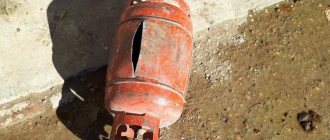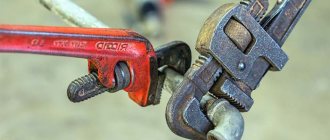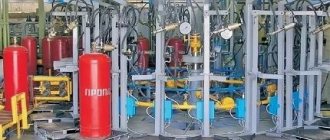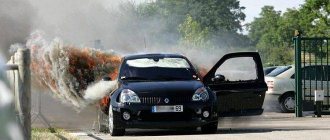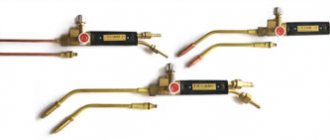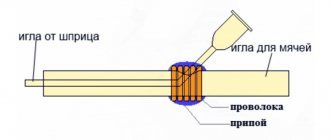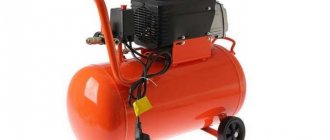Components of a gas cylinder
Requirements for production processes and technical characteristics of gas cylinders are regulated by rather old GOSTs 949-73 and 15860-84.
The maximum operating pressure in the devices ranges from 1.6 MPa to 19.6 MPa, and the wall thickness can vary from 1.5 to 8.9 mm.
The protective cap on gas cylinders can be screwed onto a special neck thread, completely closing the valve, or it can be welded to the body and only protect the valve from accidental external impacts.
A standard gas cylinder assembly consists of the following elements:
- Cylinder body.
- Valve closing cap.
- Backing rings for fixation and transportation.
- Support shoe.
Valve with shut-off valves.
An important element of the cylinder is also the technical information stamped on it.
The information stamped on the cylinder is used by service centers when refueling and re-inspecting equipment, so you should not paint it heavily
The bottom of the cylinders is shaped like a hemisphere for uniform distribution of internal pressure. For better stability of the body, a shoe is welded on the outside, on the lower edges of which there are often holes for attaching the cylinder to horizontal surfaces.
How to identify a defective or faulty product
Modern certified cylinder manufacturers produce effective designs that meet GOST requirements. If you have a counterfeit product in front of you, it is very easy to identify. You just need to know the basic standards.
The main text on the label should occupy 2/3 of its area. Moreover, all letters must be the same height, equal to 6 cm. The inscription must contain information about the weight of the empty and capacity of the full cylinder, the date of production and technical inspection, the manufacturer’s trademark, as well as other information must be indicated.
The following facts indicate a malfunction of the cylinder:
- The flywheel on the valve itself does not rotate
- Mechanical deformations are visible to the naked eye on the surface of the container or valve: scratches, abrasions, cracks, dents, traces of corrosion.
- the inscription on the label states that the technical inspection date was overdue;
- there is a smell of gas in the air;
- the cylinder shoe is installed incorrectly or damaged;
- the fitting does not have a plug.
Important information for consumers. The pressure in the cylinder must always remain! The container must not be completely emptied!
Thread on the cylinder valve
Tell me about the carving. There is a cylinder (same as in the photo). What is the output thread on the valve? The 1/2″ nut does not screw on. 5/8″ is too big. The pitch was measured with a thread gauge. We thought that most likely M22x1.75. It turned out to be inch threads from 1/2″ to 7/8″. At the same time, the market sells all adapters for them that normally screw tightly onto the thread of the cylinder. But no one knows what kind of carving this is??
Nobody knows what??
It's a metric thread.
hardly. step 1.5 is not suitable. 1.75 is suitable only for the first 4 turns, then the divergence begins. There's an inch step. But 1/2″ is not secured and 5/8″ is very loose. I would even believe that the cylinder has an oversized thread, but I have two other 10L (large) cylinders for compressed air. there is exactly the same thread. So the thread on the cylinder seems to be standard. But what kind?
for some reason I always thought that it was M22x1.75
I myself am suffering with such a cylinder, I can’t find the nut, I was thinking about cutting the thread. Asked a question about this in silence. Or like in the last post
Why don’t thread gauges (metric and inch) and calipers help? The threads are listed in the reference book based on the number of threads per inch (pitch) and outer diameter.
I myself am suffering with such a cylinder, I can’t find the nut, I was thinking about cutting the thread.
D21.7, 14 threads, 55 degrees.
Tap for cutting threads in metal.
[QUOTE][B]And so, if you are not friends with technical literature,
1. Outer diameter of the thread (accurate to tenths of a millimeter)?
2. Thread pitch (measured with a thread gauge). I have the opinion that with an inch thread gauge (no one has measured it for a thread with a profile angle of 55. I would like to know what pitch you understand.
try on the nut from the welding gearbox.
Tin
Duration: 07:51 / size: 33.73 MB
Estimate:
- 1.0
- 1
- 2
- 3
- 4
- 5
/ 2 ratings
Current rating: 1.0
views: 1406
A simple and quite accessible way to unscrew the nipple on a 5 liter propane cylinder using improvised means in a country house or garage is presented. How …
Tags: nipple propane cylinder replacing the nipple with a valve how to clamp a propane cylinder how to replace the valve on a cylinder
Link to the file as a QR code
yes, it’s really brutal... ((not even for the faint of heart to watch!!
Propane tank thread
Propane gas is used to ensure the operation of cooking stoves, heating residential, industrial and warehouse premises, refueling cars, gas welding and metal cutting. In our country, steel propane cylinders with a capacity of 5, 12, 27 and 50 liters are most often used for domestic gas supply. Such containers are easy to distinguish from others - they are always painted red. The word "PROPANE" must be written in white capital letters approximately 6 cm high.
In order to order a propane cylinder, you just need to call us or fill out the feedback form on the website. Our consultants will be happy to provide comprehensive information on any issue related to gas equipment. Our offers are transparent and profitable, just like propane gas itself.
Safety regulations
Gas cylinders with a capacity of more than 5 liters cannot be stored in a residential area - if they leak, the gas can fill the interior of the room and explode, destroying the building. Outdoor metal cabinets are used for storage. They lock to prevent theft. Placement on landings, attics, and balconies is also prohibited.
When transporting a large number of cylinders in the back of a truck, racks or Eurocontainers are needed to prevent impacts and falls of the tanks. It is convenient to transport cylinders locally in trolleys, which can be single or double.
To protect the valve from accidental impact and breakage, overhead caps are used. They come in plastic and steel. When gas welding and cutting, oxygen and gas cylinders are installed at a distance of 5 m. The same distance is maintained to hot objects (heating radiator, cutting site). The oxygen cylinder should be kept away from the oil and should not be handled with dirty hands.
Answers to questions: types of gas cylinders and their use
Propane cylinder device
Structurally, they are containers made of carbon steel 3 mm thick. A stamped bottom with a stand-shoe is welded to a single-seam welded cylinder on one side, and a hemispherical neck for installing a valve on the other. Various filling or dispensing equipment is connected to the latter. The majority of propane consuming devices (gas stoves, titaniums, welding torches, heating boilers) require reduced pressure. To do this, a reducer is installed on the valve (the most common is BPO-5-5).
On the upper part of the neck there is a passport on which the main technical parameters of the device are stamped. These include: name of the manufacturing plant, quality control department stamp, individual number, month and year of manufacture, inspection date (updated every 5 years), volume, weight in empty and filled state.
Weight and size of cylinders of various capacities
How many kg of propane are in 1 5, 12, 27, 50 liter cylinder? You can find this out in the product quality certificate or in the table below. Here you can also find out how much a 5, 12, 27, 50 liter propane cylinder weighs.
| Volume | 5 liters | 12 liters | 27 liters | 50 liters |
| Empty cylinder weight, kg | 4 | 5,5 | 14,5 | 22,0 |
| Propane tank weight, kg | 6 | 11 | 25,9 | 43,2 |
| Mass of stored gas, kg | 2 | 5,5 | 11,4 | 21,2 |
| Cylinder height, mm | 290 | 500 | 600 | 930 |
| Cylinder diameter, mm | 200 | 230 | 299 | 299 |
What is the thread on a propane tank?
Valves of the VB-2 type are installed on most household cylinders for propane-butane mixture. These shut-off devices are manufactured in accordance with GOST 21804-94 and are designed for pressures up to 1.6 MPa. The tap has a left-hand thread SP21.8-1 (6 turns), which allows you to connect any gearboxes with a union nut and a similar thread.
The valve provides a strong connection to the neck, complete tightness, has clear markings and a modern design. Threaded surfaces are lubricated with a special lubricant that reduces friction during operation. The screw plug with rubber gasket prevents gas leakage during transportation or storage. The device provides protection against unqualified repairs by persons who have not undergone appropriate training. The reliability of the locking device contributes to long-term and safe operation of the gas cylinder structure.
How many m3 of propane are in 1 5, 12, 27, 50 liter cylinder?
We have made special calculations that conditionally transform propane-butane into a gaseous state. Under standard conditions (100 kPa, 288 K), 0.526 m³ of propane or 0.392 m³ of butane is formed from 1 kg of liquefied gas. Taking into account the percentage of the mixture (60% prop.), the volume of combustible gas is calculated using the formula M*(0.526*0.6+0.392*0.4). How many cubic meters are in a propane tank can be seen in the table below. The last line shows the number of liters of propane-butane mixture (in the liquid phase).
| Cylinder capacity (l) | 5 | 12 | 27 | 50 |
| Capacity (cubic meters of flammable gas) | 0,95 | 2,59 | 5,38 | 10,01 |
| Liquid propane volume (liters) | 4,3 | 10,2 | 22,9 | 42,5 |
Screwing in new shut-off valves
Before tightening the valve, all connected parts must be degreased to prevent clogging of the locking mechanism. To do this, you can use a cloth with regular detergent or moistened with white alcohol. After this, rinse the surfaces with plain water and allow them to dry.
A new valve is never screwed to a cylinder with bare threads. It is imperative to use a sealant: special thread compound or fluoroplastic fum tape. They are applied to the lower fitting and only after that the valve is tightened.
No additional gaskets are expected to be used between the valve and the cylinder body; a seal and appropriate clamping force will suffice
The thickness of the gas fum tape is greater than sanitary tape and is 0.1 - 0.25 mm, and its reel should be yellow. The tape is wound with tension in 3-4 layers. It is better to twist it once again when it breaks than to make the seal loose.
It is advisable to tighten the valve with a torque wrench. Steel shut-off valves are screwed with a maximum force of 480 Nm, and brass valves - 250 Nm. After clamping the valve, you can proceed to subsequent steps to test the tightness of the resulting connection.
Rules for the safe operation of propane cylinders
- When using and storing, do not allow the cylinders to overheat (for example, leave them in direct sunlight for a long time);
- It is not recommended to bleed out the propane-butane mixture until the tank is completely empty (under certain conditions it can suck in air, and this is dangerous);
- When transporting, be sure to use plugs and safety caps;
- in case of detection of dents or other defects, the product must be sent for an unscheduled recheck;
- Individuals are allowed to transport no more than five cylinders in one vehicle (they must be separated by spacers from each other).
- It is necessary to constantly monitor the condition of the cylinders, because it is not for nothing that they are considered fire and explosive objects.
What is the gas pressure in a propane tank?
According to GOST 15860-84, the working pressure in the tank should not exceed 1.6 MPa. In this case, the proportion of propane in the hydrocarbon mixture must be no less than 60%. This is very important for the safe operation of gas cylinder installations. Of course, products are designed for significantly higher pressures - more than 5.0 MPa. Production and periodic tests are carried out under a pressure of 3.0 MPa.
Refueling standards
At gas cylinder refilling stations, employees are familiar with the regulations. Since a cylinder that is filled too much can explode or its valve can be torn off. So, if you refuel from a reliable supplier, you have nothing to worry about.
| Cylinder type (l) | 5 | 12 | 27 | 50 |
| Maximum permissible quantity of propane, l | 3,5 | 8,4 | 18,9 | 35 |
Detailed instructions for unscrewing the tap
Are you looking for information on how to quickly and safely turn off the tap on a propane-butane gas cylinder? Then read our instructions and see the step-by-step photos posted just below.
In order to cope without any difficulties with the valve, which can “sit tightly” in the neck of the cylinder, you will need to apply force. And, depending on the equipment at hand, you may need an assistant.
If you have only one cylinder, and you are going to twist the valve for the first time, you will have to tinker with it until you get the hang of it. If you are going to disassemble the cylinder and start making various homemade products from cylinders, then you simply cannot do without good tools at hand.
First you need to release the remaining gas, if any, in this cylinder. To do this, it is enough to turn the valve flywheel in the direction indicated on it. If there is still gas left inside, you will hear a characteristic hissing sound - this is the remaining liquefied gas coming out.
Then you need to secure the cylinder body. How to do this depends entirely on your imagination and the devices at hand. For these purposes, they use welding, metal pins, a vice, a board, clamp the cylinder with the wheel of a large car, fasten it to a tree with a belt, and many other options. Therefore, choose for yourself the method of fixation that will be convenient for you.
The main task is to immobilize the balloon. We will look at the process of unwinding a valve using the simplest example - using a vice. Step-by-step instructions can be found in the following photo collection.
Comments 50
So how do you twist an old valve? And then it seemed like they started, got stuck in the thread and forgot what they were talking about?!
Air receiver in 15 minutes... just need to find such a cylinder. I haven't seen them since 2000...
What a rarity - the price is still Soviet... 20 rubles...
Please write what size is the fitting that is screwed into the cylinder?
external thread is 34″ and internal thread is 12″, it says
Cool! How do you drain water from it?
Was there any fragrance in the bottle already?
As I understand it, one cylinder is 50.5 liters. How about pumping up atmospheres in the same way?
16 eye working pressure. More is possible, but not necessary.
Sorry 16 eyes is how much in atmospheres
Approximately 16 atmospheres.
My pleasure. 1 MPa = 10.2 atm.
How to unscrew the old valve? He's screwed there to death.
there is a left hand thread...
The first time I've heard. Are you confused? I know that it’s cone-shaped and it’s a sealant, but the fact is that it’s on the left - you’re the first one to say that, and you can see in different videos that you unscrew it counterclockwise as usual.
Cylinders WITH ANY FLAMMABLE GAS have a left-hand thread. This is done so that it is impossible to connect a pipeline with oxygen or air (right-hand thread) to a cylinder with flammable gas, since otherwise an EXPLOSIVE mixture will form. GOST 9909-81 Basic standards of interchangeability. The conical thread of valves and gas cylinders is funny because no one can unscrew it... because they tighten it instead of unscrewing it
On any forum, upon request, how to unscrew the valve from a gas cylinder, I will prove the opposite to you. It turns out that in all the videos on YouTube people are unscrewing the valve against the thread? Then our country cannot be defeated!
I don’t need to prove anything, look at the view “d” in the picture... my cylinder had a LEFT THREAD
Dear, I’m holding a wuntel in my hands, the thread is normal - not left-handed.
How much does a 5, 12, 27, 50 liter propane cylinder cost?
The price depends on the specific area in which the customer lives. How much an empty propane cylinder costs in our region, as well as the cost of refilling, is shown in the following table:
| Cylinder volume (liters) | 5 | 12 | 27 | 50 |
| Estimated cost of an empty new cylinder | 1080 | 1380 | 1500 | 2250 |
| Cost of refilled propane | 1155 | 1560 | 1905 | 3000 |
*prices are indicative depending on the manufacturer
The price of a cylinder is sometimes several times higher than the cost of the contents. But repeated refilling allows the tanks to be used for many years and even decades.
ACCEPTANCE RULES
- 3.1. Each cylinder must be subjected to acceptance tests.
- 3.2. Cylinders are accepted in batches of up to 400 pcs. the same volume, size and the same heat treatment regime.
- 3.3. Acceptance tests include: hydraulic pressure strength tests;
- pneumatic pressure leak test;
- tensile test;
- impact bending test;
- control of thread geometric parameters;
- visual inspection;
- determination of mass;
- determination of volume.
(Changed edition, Amendment No. 5).
3.4. The tensile test should be carried out on short longitudinal specimens. Samples in their calculation part should not be straightened. 3.5. The impact strength test must be carried out on longitudinal samples of type 3 according to GOST 9454. The axis of the notch must be perpendicular to the wide edges of the sample. Cylinders with a wall thickness of at least 5 mm are tested. 3.6. For tensile and impact bending tests, samples are cut from the bodies of finished cylinders or witness pipes, cut from the pipes from which a given batch of cylinders is made, and heat treated together with the cylinders of a given batch, and from alloy steel - also from one melt.
It is allowed to equip up to 15% of cylinders in a batch made of alloy steel with cylinders made of alloy steel of other melts, the batches of which have passed acceptance tests.
For each test, at least two samples are taken from the lot.
3.5, 3.6. (Changed edition, Amendment No. 5).3.7. If the test results do not comply with the requirements of this standard, tests are carried out on twice the number of samples. The results of the spot check apply to the entire lot. (Changed edition, Amendment No. 3).3.8. Acetylene cylinders must be tested for leaks at factories that fill the cylinders with porous mass.
(Introduced additionally, Amendment No. 3).
Where to buy a propane tank
Our company provides you with the opportunity to buy propane at a competitive price.
Our region has a wide network of certified companies selling and refilling cylinders. The most common are tanks with a capacity of 27 and 50 liters, but upon pre-order, you will be supplied with products of 5 or 12 liters in the shortest possible time.
When refueling, of course, it’s faster to exchange your cylinder for an already filled one. However, many people prefer to wait a little to get theirs back. After all, it definitely does not allow gas to pass through and passed the necessary tests on time. The operator himself ensures that the amount of liquid propane does not exceed 85% of the geometric capacity of the vessel. This is necessary so that when heated, the internal pressure does not exceed the permissible threshold. If there are residual contents at the bottom (so-called condensate), the refiller must drain it into a special container.
Cylinders for technical gases.
Cylinders for technical gases.
Oxygen cylinders
designed for oxygen refilling and its further storage and transportation. Manufactured according to GOST 949-73.
Oxygen balloon
filled with gas to a pressure of 150 atm.
The working and test pressure of the cylinder is stamped by the manufacturer at the bottom of the passport, which is stamped in the upper part of the cylinder under the neck. (P150 atm P225 atm) or (P200 atm P300 atm). Once every five years, cylinders undergo mandatory technical certification, undergoing a hydraulic pressure test of 225 or 300 atm. Oxygen cylinders come in different sizes from 1 to 50 liters (small or medium volume) and are painted blue or blue with the inscription oxygen in black. Oxygen cylinders from 5 to 50 liters are equipped with valves VK-94-01
, VK-99
.
Small volume cylinders from 1 to 10 liters can be equipped with a VK-94-01 valve, used.
07. Oxygen cylinders for medical gas are equipped with a
VKM-95
made of stainless steel. Medical oxygen is used for medical purposes for breathing apparatus, oxygen cocktails, etc.
Cylinders for technical gases manufactured in accordance with GOST 949-73 can be designed for different types of gases. ( Argon
, carbon dioxide , nitrogen , welding mixture
, etc.).
They also differ in volume. The cylinder must not have mechanical damage, traces of loose rust, or welding. All elements of the cylinder (shoe, neck) are attached to the shell using hot crimping. The cylinder passport must be easy to read. The service life of a cylinder produced since the beginning of 2015, according to the order of Rostechnadzor dated March 25, 2014, is 20 years
.
Gas content in the cylinder;
Oxygen, argon, nitrogen, helium, welding mixtures: a 40-liter cylinder at 150 atm contains - 6 cubic meters. m/8kg. Acetylene: 40-liter cylinder at 19 kgf/cm2 – 4.5 cubic meters. m / 5.5 kg of dissolved acetylene. Carbon dioxide: 40-liter cylinder - 12 cubic meters. m / 24 kg of liquid gas Propane: 50-liter cylinder -10 cubic meters. m / 42 liters of liquid gas / 21 kg of gas.
Empty cylinder weight 40 liters
: Oxygen, argon, nitrogen, helium, carbon dioxide, welding mixtures, amounts to 65-70 kg without taking into account the weight of the protective cap.
Weight of a 40 liter acetylene cylinder
:
– 90 kg Weight of a 50 liter propane cylinder
:
– 22 kg
Threads for valves in the necks of cylinders according to GOST 9909-81.
W19.2 – from 1 to 10 liters. W27.8 - 40 liters of oxygen, carbon dioxide, argon, helium, as well as 5, 12, 27 and 50 liters of propane. W30.3 – 40 liters acetylene.
Thread on the valve for connecting the gearbox:
G1/2″ – found on cylinders from 1 to 10 liters; a special
adapter
. G3/4″ – standard thread on 40-liter cylinders. oxygen, carbon dioxide, argon, helium, welding mixture. SP 21.8×1/14″ – left-hand thread for propane.
Detailed instructions for unscrewing the tap
Are you looking for information on how to quickly and safely turn off the tap on a propane-butane gas cylinder? Then read our instructions and see the step-by-step photos posted just below.
In order to cope without any difficulties with the valve, which can “sit tightly” in the neck of the cylinder, you will need to apply force. And, depending on the equipment at hand, you may need an assistant.
If you have only one cylinder, and you are going to twist the valve for the first time, you will have to tinker with it until you get the hang of it. If you are going to disassemble the cylinder and start making various homemade products from cylinders, then you simply cannot do without good tools at hand.
First you need to release the remaining gas, if any, in this cylinder. To do this, it is enough to turn the valve flywheel in the direction indicated on it. If there is still gas left inside, you will hear a characteristic hissing sound - this is the remaining liquefied gas coming out.
Then you need to secure the cylinder body. How to do this depends entirely on your imagination and the devices at hand. For these purposes, they use welding, metal pins, a vice, a board, clamp the cylinder with the wheel of a large car, fasten it to a tree with a belt, and many other options. Therefore, choose for yourself the method of fixation that will be convenient for you.
The main task is to immobilize the balloon. We will look at the process of unwinding a valve using the simplest example - using a vice. Step-by-step instructions can be found in the following photo collection.
Comments 50
So how do you twist an old valve? And then it seemed like they started, got stuck in the thread and forgot what they were talking about?!
Air receiver in 15 minutes... just need to find such a cylinder. I haven't seen them since 2000...
What a rarity - the price is still Soviet... 20 rubles...
Please write what size is the fitting that is screwed into the cylinder?
external thread is 34″ and internal thread is 12″, it says
Cool! How do you drain water from it?
Was there any fragrance in the bottle already?
As I understand it, one cylinder is 50.5 liters. How about pumping up atmospheres in the same way?
16 eye working pressure. More is possible, but not necessary.
Sorry 16 eyes is how much in atmospheres
Approximately 16 atmospheres.
My pleasure. 1 MPa = 10.2 atm.
How to unscrew the old valve? He's screwed there to death.
there is a left hand thread...
The first time I've heard. Are you confused? I know that it’s cone-shaped and it’s a sealant, but the fact is that it’s on the left - you’re the first one to say that, and you can see in different videos that you unscrew it counterclockwise as usual.
Cylinders WITH ANY FLAMMABLE GAS have a left-hand thread. This is done so that it is impossible to connect a pipeline with oxygen or air (right-hand thread) to a cylinder with flammable gas, since otherwise an EXPLOSIVE mixture will form. GOST 9909-81 Basic standards of interchangeability. The conical thread of valves and gas cylinders is funny because no one can unscrew it... because they tighten it instead of unscrewing it
On any forum, upon request, how to unscrew the valve from a gas cylinder, I will prove the opposite to you. It turns out that in all the videos on YouTube people are unscrewing the valve against the thread? Then our country cannot be defeated!
I don’t need to prove anything, look at the view “d” in the picture... my cylinder had a LEFT THREAD
Dear, I’m holding a wuntel in my hands, the thread is normal - not left-handed.
Cylinders for technical gases.
Cylinders for technical gases.
Cylinders for technical gases.
Oxygen cylinders
designed for oxygen refilling and its further storage and transportation. Manufactured according to GOST 949-73.
Oxygen balloon
filled with gas to a pressure of 150 atm.
The working and test pressure of the cylinder is stamped by the manufacturer at the bottom of the passport, which is stamped in the upper part of the cylinder under the neck. (P150 atm P225 atm) or (P200 atm P300 atm). Once every five years, cylinders undergo mandatory technical certification, undergoing a hydraulic pressure test of 225 or 300 atm. Oxygen cylinders come in different sizes from 1 to 50 liters (small or medium volume) and are painted blue or blue with the inscription oxygen in black. Oxygen cylinders from 5 to 50 liters are equipped with valves VK-94-01
, VK-99
.
Small volume cylinders from 1 to 10 liters can be equipped with a VK-94-01 valve, used.
07. Oxygen cylinders for medical gas are equipped with a
VKM-95
made of stainless steel. Medical oxygen is used for medical purposes for breathing apparatus, oxygen cocktails, etc.
Cylinders for technical gases manufactured in accordance with GOST 949-73 can be designed for different types of gases. ( Argon
, carbon dioxide , nitrogen , welding mixture
, etc.).
They also differ in volume. The cylinder must not have mechanical damage, traces of loose rust, or welding. All elements of the cylinder (shoe, neck) are attached to the shell using hot crimping. The cylinder passport must be easy to read. The service life of a cylinder produced since the beginning of 2015, according to the order of Rostechnadzor dated March 25, 2014, is 20 years
.
Gas content in the cylinder;
Oxygen, argon, nitrogen, helium, welding mixtures: a 40-liter cylinder at 150 atm contains - 6 cubic meters. m/8kg. Acetylene: 40-liter cylinder at 19 kgf/cm2 - 4.5 cubic meters. m / 5.5 kg of dissolved acetylene. Carbon dioxide: 40-liter cylinder - 12 cubic meters. m / 24 kg of liquid gas Propane: 50-liter cylinder -10 cubic meters. m / 42 liters of liquid gas / 21 kg of gas.
Empty cylinder weight 40 liters
: Oxygen, argon, nitrogen, helium, carbon dioxide, welding mixtures, amounts to 65-70 kg without taking into account the weight of the protective cap.
Weight of acetylene cylinder 40 liters
:
- 90 kg Weight of propane cylinder 50 liters
:
- 22 kg
Threads for valves in the necks of cylinders according to GOST 9909-81.
W19.2 - from 1 to 10 liters. W27.8 - 40 liters of oxygen, carbon dioxide, argon, helium, as well as 5, 12, 27 and 50 liters of propane. W30.3 - 40 liters of acetylene.
Thread on the valve for connecting the gearbox:
G1/2″ - found on cylinders from 1 to 10 liters; a special
adapter
. G3/4″ – standard thread on 40-liter cylinders. oxygen, carbon dioxide, argon, helium, welding mixture. SP 21.8×1/14″ - left-hand thread for propane.
OKP 14 1200
By Decree of the State Committee of Standards of the Council of Ministers of the USSR of December 19, 1973 N 2717, the introduction date was set from 01/01/75.
By Decree of the USSR State Standard dated August 14, 1991 N 1352, the validity period was lifted.
This standard applies to cylinders made of carbon and alloy steel, small volume - up to 12 l and medium volume - from 20 to 50 l with a working pressure of up to 19.6 MPa (200 kgf/cm2), made from seamless pipes and intended for storage and transportation of compressed , liquefied and dissolved gases at temperatures from minus 50 to plus 60°C.
The standard complies with the CMEA standardization recommendation PC 2496-70.
The valve structure on a gas cylinder and how to replace it if necessary
Cylinders are universal equipment for storing and transporting gaseous substances for domestic and industrial purposes. The shut-off valves in them do not last forever, so over time the valve on the gas cylinder needs to be replaced. You can do it yourself, following a number of safety rules.
We will tell you how to choose the right valve for equipping a gas cylinder. For independent craftsmen, we provide detailed instructions on how to change a worn-out device. Here you will learn what safety measures must be observed when installing a shut-off device on a gas tank.
Leak test
To check the tightness of shut-off valves, gas is pumped into the vessel under pressure using a compressor or two cylinders are connected with a hose - the one being tested (empty) and the other filled with gas. The test vessel is filled with gas up to 2 atm, control is carried out using a pressure gauge. Apply soap foam to the threaded connection and open the valve slightly. If soap bubbles do not appear, then there are no leaks, otherwise you need to re-tighten the valve and tighten the nuts.
The test is performed several times in a row, in the open and closed positions, using new foam. It is strictly prohibited to check the tightness with a match or lighter - due to the risk of fire and explosion of the gas-air mixture. It is important to know about the dangerous mistake that users make with left-handed gearbox threads; if, out of habit, they are tightened incorrectly, then leaks will become larger.
Components of a gas cylinder
Requirements for production processes and technical characteristics of gas cylinders are regulated by rather old GOSTs 949-73 and 15860-84.
The maximum operating pressure in the devices ranges from 1.6 MPa to 19.6 MPa, and the wall thickness can vary from 1.5 to 8.9 mm.
A standard gas cylinder assembly consists of the following elements:
- Cylinder body.
- Valve with shut-off valves.
- Valve closing cap.
- Backing rings for fixation and transportation.
- Support shoe.
An important element of the cylinder is also the technical information stamped on it.
The bottom of the cylinders is shaped like a hemisphere for uniform distribution of internal pressure. For better stability of the body, a shoe is welded on the outside, on the lower edges of which there are often holes for attaching the cylinder to horizontal surfaces.
You will learn about the types of gas cylinders and the features of their markings in this article, which we recommend viewing and reading.
To come in
Already registered? Sign in here.
There are currently 0 users on the page
There are no users viewing this page.
Conical threads with a taper of 3:25 are used for valves and gas cylinders. With a pitch of 1.814 (mm), its working length is 24 (mm) - 26 (mm), and the nominal diameter ranges from 19.2 (mm) to 30.3 (mm).
Standard gas thread sizes:
- Nominal diameter: 19.2 (mm), 27.8 (mm), 30.3 (mm).
- Pitch: 1.814 (mm).
- Working thread length: 24 (mm), 26 (mm).
- External thread length: 16.000 (mm), 17.667 (mm).
According to individual requirements, it is possible to increase the thread length taking into account the valve design.
Important: for some gas thread parameters, maximum deviations are permissible. For the peak and valley it should not exceed ±0.025 (mm), for the step - 0.04 (mm) - 0.07 (mm), for the length - ± 0.03 (mm) - ± 0.07 (mm). The angle of the external thread should not deviate from the norm by more than 1°, internal thread - 1°30°.
The axial displacement of the plane of gas threads from its nominal location cannot exceed ± 1.5 (mm).
Marking:
For example: W 19.2 – gas thread with a nominal diameter of 19.2 (mm).
The main regulatory document is GOST 9909-81.
Types and design of valves
The threads of valves for gas cylinders are standardized, but they themselves can have a variety of designs. The choice of valve model is influenced by the type of chemical substance being stored, production features of operation and the amount of money.
Before purchasing new equipment, you should familiarize yourself with the design options and the internal structure of the valves.
Classification of shut-off valves for cylinders
The design features of gas cylinder valves are determined not by the whims of engineers, but by safety considerations.
Depending on the material used, shut-off valves are divided into brass and steel . The choice of metal for the manufacture of the valve body is determined by the type of gases contained in the cylinder.
There are the following types of shut-off valves, depending on the type of chemicals stored:
- Acetylene. The body of such cylinders is painted white. Special valves are used in cylinders containing acetylene, chlorine, ammonia and other aggressive substances.
- Oxygen . The cylinders are painted blue and are intended for storing oxygen, argon, hydrogen, nitrogen, carbon dioxide and other inert gases.
- Propane-butane . They are painted red and are intended for storing substances corresponding to the name and other gaseous hydrocarbons. The most common valve type model for such a cylinder is VB-2.
Valves for acetylene cylinders are not made of brass because the substances they contain may react chemically with copper. Typically, carbon or alloy steel is used to manufacture shut-off valves of this type.
Detailed instructions for unscrewing the tap
Are you looking for information on how to quickly and safely turn off the tap on a propane-butane gas cylinder? Then read our instructions and see the step-by-step photos posted just below.
In order to cope without any difficulties with the valve, which can “sit tightly” in the neck of the cylinder, you will need to apply force. And, depending on the equipment at hand, you may need an assistant.
If you have only one cylinder, and you are going to twist the valve for the first time, you will have to tinker with it until you get the hang of it. If you are going to disassemble the cylinder and start making various homemade products from cylinders, then you simply cannot do without good tools at hand.
First you need to release the remaining gas, if any, in this cylinder. To do this, it is enough to turn the valve flywheel in the direction indicated on it. If there is still gas left inside, you will hear a characteristic hissing sound - this is the remaining liquefied gas coming out.
Then you need to secure the cylinder body. How to do this depends entirely on your imagination and the devices at hand. For these purposes, they use welding, metal pins, a vice, a board, clamp the cylinder with the wheel of a large car, fasten it to a tree with a belt, and many other options. Therefore, choose for yourself the method of fixation that will be convenient for you.
The main task is to immobilize the balloon. We will look at the process of unwinding a valve using the simplest example - using a vice. Step-by-step instructions can be found in the following photo collection.
Are you here
How to disassemble a gas cylinder: step-by-step instructions, precautions
Home Automotive gas cylinders Cylindrical Cylindrical cylinder
Products are certified in accordance with UNECE rules R67-01
Cargo cylinders AG-76,90,100,103,105,122,130,151,210 can be shipped either complete with a protective casing for the valve block or without it at the customer’s request.
The thickness of the steel sheet used for the production of cylinders AG30,35,40,45,50,55,60,65 is 2.5 or 3 mm, for cylinders AG-60...122 - 3 mm, for cylinders AGG130..210 - 3.5 mm.
The available capacities allow the production of any cylindrical containers with a volume of up to 250 liters (hydraulic accumulator tanks, receivers, etc.)
Installation, repair and maintenance of gas cylinder equipment must be carried out by a specialized enterprise with service personnel who have undergone special training and have a standard certificate.
Characteristics:
| Name | Designation | Volume, l. | Length, mm. | Diameter, mm. |
| Automotive cylinder AG-30 | NZ 81.00.00-14 | 30 | 501 | 300 |
| Automotive cylinder AG-35 | GLIU.391.00.00 | 35 | 861 | 240 |
| Automotive cylinder AG-40 | NZ 81.00.00-07 | 40 | 651 | 300 |
| Automotive cylinder AG-40 | GLIU.391.00.00-01 | 40 | 981 | 240 |
| Automotive cylinder AG-50 | NZ 81.00.00 | 50 | 796 | 300 |
| Automotive cylinder AG-50 | NZ 119.00.00-14 | 50 | 550 | 376 |
| Automotive cylinder AG-55 | GLIU 272.00.00-02 | 55 | 800 | 315 |
| Automotive cylinder AGG-56 | GLIU 341.00.00-05 | 56 | 547 | 400 |
| Automotive cylinder AG-60 | NZ 81.00.00-05 | 60 | 945 | 300 |
| Automotive cylinder AG-60 | GLIU 272.00.00-03 | 60 | 866 | 315 |
| Automotive cylinder AG-60 | NZ 119.00.00-13 | 60 | 645 | 376 |
| Automotive cylinder AG-65 | NZ 81.00.00-04 | 65 | 1003 | 300 |
| Automotive cylinder AG-65 | GLIU 272.00.00-01 | 65 | 933 | 315 |
| Automotive cylinder AG-65 | NZ 119.00.00-12 | 65 | 689 | 376 |
| Automotive cylinder AGG-76 | NZ 119.00.00-05 | 76 | 789 | 376 |
| Automotive cylinder AGG-90 | NZ 119.00.00-04 | 90 | 919 | 376 |
| Automotive cylinder AGG-90 | GLIU.341.00.00-09 | 90 | 842 | 400 |
| Automotive cylinder AGG-90 | NZ 119.00.00-16 | 90 | 1402 | 300 |
| Automotive cylinder AGG-100 | NZ 119.00.00-03 | 100 | 1008 | 376 |
| Automotive cylinder AGG-100 | GLIU.341.00.00-10 | 100 | 906 | 400 |
| Automotive cylinder AGG-102 | GLIU.272.00.00-09 | 102 | 1430 | 315 |
| Automotive cylinder AGG-105 | NZ 119.00.00-01 | 105 | 1064 | 376 |
| Automotive cylinder AGG-122 | NZ 119.00.00-06 | 122 | 1217 | 376 |
| Automotive cylinder AGG-130 | GLIU.341.00.00-02 | 130 | 1159 | 400 |
| Automotive cylinder AGG-130 | 0306-4434-200-07 | 130 | 813 | 490 |
| Automotive cylinder AGG-146 |
Preliminary application

